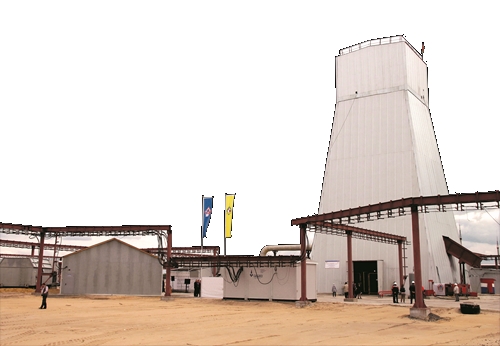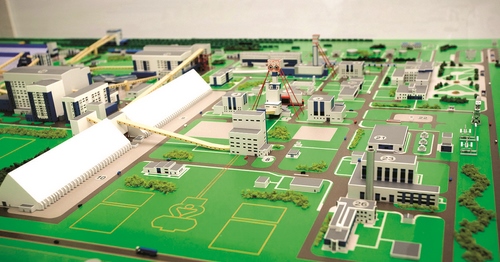
Construction works in full swing. Photo BelTA
Development of the investment project at Petrikov deposit of potash salts began in 2012, to supply Belaruskali JSC. Much has been achieved in a short period of time, with over 150 hectares cleared of vegetation, to prepare for industrial operations. Besides laying access railway tracks, and launching a power substation, engineers have opened various technical buildings, renovating buildings from the former plant where possible.
“The site is notable for its size,” stresses the Director of the Petrikov mining and processing complex (under construction), Alexander Zhevlakov. He explains, “We previously built only enterprises to extract ore, but are now working on a mining and processing complex. Our previous experience helps, since we’re familiar with geological and research works.”
Engineering infrastructure is being installed as tunnelling takes place, to allow the mine to launch as soon as possible. The huge steel cone of the drill will be reaching down to salt deposits at a depth of about 800m below ground. The hardness of the soil and its water content have to be taken into account. This problem was solved via digging over 40 wells, to a depth of 275m, creating an ice tunnel through which the first passing will be launched. Meanwhile, to avoid the soil collapsing, the first 40m will have to be dug manually, with the help of shaft sinkers’ chief aide. A KC-3 pneumatic loader acts as a hand-operated mini-excavator, using a grab instead of a spade, able to remove 0.3 cubic metres of soil in every scoop. The earth is then loaded into a tub and lifted to the surface via a crane.
Entering the mine, the foreman of the tunnelling site, Dmitry Grebenek, demonstrates how the pneumo-loader operates. It’s obvious that handling this equipment demands remarkable endurance. There’s no need to go to the gym afterwards. Returning to the surface, Dmitry comments, “All of us have spent time in mines but this one will be deeper and wider, taking more time to tunnel. Of course, we’ll manage, to the benefit of the country, and we’ll be cheering when we reach the salt deposits.”

Model of future factory. Photo: Pavel Chuiko
Those taking part in construction truly do boast experience, having worked at Krasnoslobodsky and Berezovsky mines. Their experience cannot be overestimated. In fact, the Belarusian salt mine is the only such within the former Soviet Union. Our workers’ skills are in demand far and wide. The General Director of Shakhtospetsstroy Trust JSC, Denis Diulin, comments, “We’re completing work in Turkmenistan at present. After low-quality intervention by a foreign company, local trucks flooded and our shaft sinkers had to step in. The consequences of the accident have now been tackled, and work is soon to draw to a close.”
Meanwhile, work is in full swing at the Petrikov deposit: the launch of the complex’s first stage is scheduled for December 2019. In 2021, the site should be fully operational. Naturally, time is money. In line with the project, investments will account for $1.5bn (in Rouble equivalent, exceeding 1 trillion).
“Over the past decade, Belaruskali has taken on the joint building of three mines, working with other construction organisations,” underlines Belaruskali’s General Director, Ivan Golovaty. He comments, “We’re using domestic technologies produced by Belarus’ machine-building branch, constructing a 21st century mine able to produce high-quality volumes.”
Specialists are already speaking about the long-term prospects of the major project. Extracting 7-8 tonnes of potassium salts annually, the Petrikov deposit should last a full century. The mines will be the country’s largest and should inspire the region’s social-economic development. An entire town is likely to be built to serve the site, with two 59-apartment houses already being used to accommodate workers, in the neighbouring district centre. Many more will follow.
By Ruslan Proleskovsky











